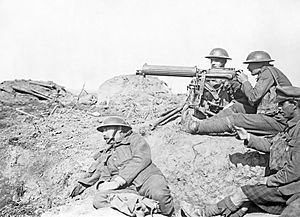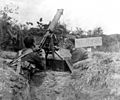Vickers machine gun facts for kids
Quick facts for kids Vickers Medium Machine Gun |
|
|---|---|

A typical Vickers machine gun crew in action
|
|
| Type | Medium machine gun |
| Place of origin | United Kingdom |
| Service history | |
| In service | 1912–1968 |
| Used by | See Users |
| Wars | World War I Chaco War World War II Indo-Pakistan War of 1947 1948 Arab–Israeli War Korean War The Troubles Congo Crisis South African Border War |
| Production history | |
| Designed | 1912 |
| Manufacturer | Vickers |
| Produced | 1912–1968 |
| Specifications | |
| Mass | 33–51 lb (15–23 kg) all-up |
| Length | 3 ft 8 in (1.12 m) |
| Barrel length | 28 in (720 mm) |
| Crew | three man crew |
|
|
|
| Cartridge | .303 British |
| Action | recoil with gas boost |
| Rate of fire | 450 to 500 round/min |
| Muzzle velocity | 2440 ft/s (744 m/s) |
| Effective firing range | 2,187 yd (2,000 m) |
| Maximum firing range | 4,500 yd (4,100 m) indirect fire |
| Feed system | 250-round canvas belt |
The Vickers machine gun, often called the Vickers gun, was a powerful machine gun. It was used by the British Army for a very long time, from 1912 all the way to 1968. This gun was built by a company called Vickers Limited. It was known for being extremely reliable, meaning it almost always worked when needed. The Vickers gun became one of the most important weapons used during World War I.
Contents
What is the Vickers Machine Gun?
The Vickers machine gun was a heavy weapon. It needed a team of three soldiers to operate it properly. One soldier would fire the gun, another would feed the ammunition belt, and a third would help carry the parts and keep it supplied.
How the Vickers Gun Worked
The Vickers gun used a system called "recoil with gas boost." This means that when a bullet was fired, the force of the shot (recoil) helped to load the next bullet. A special gas system also helped make this process smoother and faster.
It fired bullets very quickly, about 450 to 500 rounds (bullets) per minute. The bullets traveled at a speed of about 744 meters per second. This made it a very effective weapon for defending positions or providing covering fire.
The gun was fed by a long canvas belt that held 250 rounds of .303 British ammunition. This type of ammunition was common for British firearms at the time.
Key Features of the Vickers Gun
- Water-cooled: The Vickers gun had a water jacket around its barrel. This water helped to cool the barrel down during continuous firing. Without it, the barrel would get too hot and could melt or warp.
- Heavy and stable: The gun itself weighed about 33 to 51 pounds (15 to 23 kg). When set up on its tripod, it was very stable. This stability helped make its shots accurate, even when firing many bullets quickly.
- Long range: It could hit targets up to 2,000 meters away. For indirect fire (shooting over obstacles), its maximum range was even further, about 4,100 meters.
Where the Vickers Gun Was Used
The Vickers machine gun was used in many conflicts around the world. Its long service life shows how effective and trusted it was.
Major Wars and Conflicts
- World War I (1914-1918): This was where the Vickers gun became famous. It was crucial for trench warfare, helping soldiers defend their lines.
- World War II (1939-1945): Even decades later, the Vickers gun was still in use during the second global conflict.
- Korean War (1950-1953): British and Commonwealth forces continued to use the Vickers gun in Korea.
- Other conflicts: It also saw action in wars like the Chaco War, the Indo-Pakistan War of 1947, and the Congo Crisis.
Use in Aircraft
The Vickers gun was not just for ground troops. It was also adapted to be used on aircraft. Early fighter planes in World War I used Vickers guns. They had a special device called an "interrupter gear." This gear allowed the machine gun to fire through the spinning propeller blades without hitting them.
Images for kids
-
A Vickers machine gun crew in action at the Battle of the Menin Road Ridge, September 1917
-
An Indian Army Vickers machine gun crew in the North West Frontier, India, 1940.
-
Australian soldiers of the 3rd Battalion, Royal Australian Regiment operate a Vickers gun during fighting near Chipyong-ni during the Korean War, February 1951
-
Clinometer for Vickers .303 machine gun, used to set the gun's angle.
-
British Vickers gun team in action at the Battle of the Somme. Both are wearing gas masks.
-
British Vickers gunners in action in the Netherlands during Operation Market Garden. All are wearing the Mk III Turtle helmet.
-
British commandos on the outskirts of Wesel during Operation Plunder in 1945.
-
View of the breech of a Vickers gun showing brass feed ramp.
See also
 In Spanish: Ametralladora Vickers para niños
In Spanish: Ametralladora Vickers para niños

















